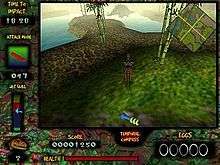Nanosaur
Nanosaur is a science fiction third person shooter video game developed by Pangea Software and published by Ideas From the Deep for Mac OS 9 and Microsoft Windows. The player takes on the form of a Nanosaur, a genetically engineered intelligent dinosaur from the future, sent back in time just prior to the Cretaceous–Paleogene extinction event.
| Nanosaur | |
|---|---|
| Developer(s) | Pangea Software (Mac) Ideas From the Deep (Windows) |
| Publisher(s) | Pangea Software (Mac) Ideas From the Deep (Windows) |
| Producer(s) | Lane Roathe (PC) |
| Programmer(s) | Brian Greenstone (Mac) Rebecca Ann Heineman (Windows) Eric Drumbor (Windows) Lane Roathe (Windows) |
| Artist(s) | Scott Harper Chris Ashton (cinematics) |
| Composer(s) | Mike Beckett Jens Nilsson |
| Series | Nanosaur |
| Platform(s) | Macintosh, Windows |
| Release | Macintosh Windows
|
| Genre(s) | Third person shooter, science fiction |
| Mode(s) | Single-player |
Story

In the distant year of 4122, a dinosaur species, Nanosaurs, rule the Earth. Their civilization originated from a group of human scientists who experimented with genetic engineering. Their experimentation led them to resurrect the extinct dinosaur species; however, their victory was short lived, as a disastrous plague brought the end of their civilization itself. The few dinosaurs resurrected were lent an unusual amount of intelligence from their human creators, leaving them to expand on their growing civilization. However, as the Nanosaurs were the only species on Earth, inbreeding was the only possible choice of reproduction. This method largely affected the intelligence of the various offspring, and slowly began to pose a threat to their once-intelligent society.
The Nanosaur government offers a quest that involves time traveling into the year 65 million BC, where the five eggs of ancient dinosaur species must be retrieved and placed in a time portal leading to the present year. Their high-ranking agent, a brown Deinonychus Nanosaur, is chosen to participate in this mission. On the day of her mission, she is teleported to the past via a time machine in a Nanosaur laboratory.
The Nanosaur arrives in a lush jungle, with twenty minutes given to collect the eggs before the meteor that caused the initial extinction of the dinosaur race hits the Earth. After battling various Tyrannosaurus rex's, the Nanosaur enters a volcanic crater, where she must cross several stone formations in a river of lava in order to retrieve the eggs. After making her way across the river, the Nanosaur detects the final eggs in a canyon oasis, where various dinosaurs, namely Dilophosaurus and Stegosaurus, are attempting to hinder her progress in order to protect their eggs. After evading defeat, the Nanosaur beams the final egg into the time portal, and is carried along with it back to the present.
Following the completion of the Nanosaur's mission, the eggs are placed in nationwide laboratories, where the scientists intend on breeding them for their own purposes. Several months following this event, the eggs finally start to hatch.
Gameplay
The object of the game is to collect the eggs of five dinosaur and flying reptile species and deposit them in time portals to the future in twenty minutes; at the end of the countdown, the asteroid that caused the Cretaceous–Paleogene extinction event hits Earth. The Nanosaur is equipped with a "fusion blaster" (a basic multi-purpose energy weapon), a jet pack allowing flight, a temporal compass for locating time portals, and a GPS locator for navigation.
The native animals will attack the Nanosaur when their eggs are threatened; species encountered include Tyrannosaurus rex, Stegosaurus, Triceratops, Dilophosaurus (who spits venom as in Jurassic Park), and the flying reptile Pteranodon. As well as hostile creatures, the Nanosaur must also avoid water and lava, environmental hazards which slow the player down (or kill it).
Legacy
The game was being ported to Linux by Three Axis Interactive, but the port was never completed.[2] Around 2003 the source code of the game was made available by the developer under a restrictive license.[3]
Nanosaur Extreme is another version of Nanosaur, released at a later time with heftier system requirements. It has many more enemies and weapons than Nanosaur, and it is described on the Nanosaur downloads page as "what Nanosaur was meant to be - a total kill-fest".
Nanosaur 2: Hatchling, a continuation of the original Nanosaur storyline, was released in March 2004 Nanosaur 2 is the first stereoscopic game released for the Mac.[4]
References
- Nanosaur v1.0.8 Instructions (Game manual). 1998.
- Nanosaur posts LinuxGames
- nanosource on pangeasoft.net
- "Inside Mac Games Preview: Nanosaur 2: Hatchling". Insidemacgames.com. Retrieved 2014-05-09.